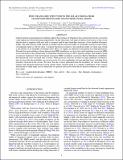Files in this item
Fine strand-like structure in the solar corona from magnetohydrodynamic transverse oscillations
Item metadata
| dc.contributor.author | Antolin, P. | |
| dc.contributor.author | Yokoyama, T. | |
| dc.contributor.author | Van Doorsselaere, T. | |
| dc.date.accessioned | 2017-02-13T16:30:12Z | |
| dc.date.available | 2017-02-13T16:30:12Z | |
| dc.date.issued | 2014-05-13 | |
| dc.identifier | 248969974 | |
| dc.identifier | fd1a0121-8755-45eb-b017-7f8273cbede3 | |
| dc.identifier | 84901350040 | |
| dc.identifier.citation | Antolin , P , Yokoyama , T & Van Doorsselaere , T 2014 , ' Fine strand-like structure in the solar corona from magnetohydrodynamic transverse oscillations ' , Astrophysical Journal Letters , vol. 787 , no. 2 , L22 . https://doi.org/10.1088/2041-8205/787/2/L22 | en |
| dc.identifier.issn | 2041-8205 | |
| dc.identifier.other | BibCode: 2014ApJ...787L..22A | |
| dc.identifier.uri | https://hdl.handle.net/10023/10279 | |
| dc.description.abstract | Current analytical and numerical modeling suggest the existence of ubiquitous thin current sheets in the corona that could explain the observed heating requirements. On the other hand, new high resolution observations of the corona indicate that its magnetic field may tend to organize itself in fine strand-like structures of few hundred kilometers widths. The link between small structure in models and the observed widths of strand-like structure several orders of magnitude larger is still not clear. A popular theoretical scenario is the nanoflare model, in which each strand is the product of an ensemble of heating events. Here, we suggest an alternative mechanism for strand generation. Through forward modeling of three-dimensional MHD simulations we show that small amplitude transverse MHD waves can lead in a few periods time to strand-like structure in loops in EUV intensity images. Our model is based on previous numerical work showing that transverse MHD oscillations can lead to Kelvin-Helmholtz instabilities that deform the cross-sectional area of loops. While previous work has focused on large amplitude oscillations, here we show that the instability can occur even for low wave amplitudes for long and thin loops, matching those presently observed in the corona. We show that the vortices generated from the instability are velocity sheared regions with enhanced emissivity hosting current sheets. Strands result as a complex combination of the vortices and the line-of-sight angle, last for timescales of a period, and can be observed for spatial resolutions of a tenth of loop radius. | |
| dc.format.extent | 6 | |
| dc.format.extent | 1082720 | |
| dc.language.iso | eng | |
| dc.relation.ispartof | Astrophysical Journal Letters | en |
| dc.subject | Magnetohydrodynamics (MHD) | en |
| dc.subject | Sun: activity | en |
| dc.subject | Sun: corona | en |
| dc.subject | Sun: filaments | en |
| dc.subject | Prominences | en |
| dc.subject | Sun: oscillations | en |
| dc.subject | QB Astronomy | en |
| dc.subject | QC Physics | en |
| dc.subject.lcc | QB | en |
| dc.subject.lcc | QC | en |
| dc.title | Fine strand-like structure in the solar corona from magnetohydrodynamic transverse oscillations | en |
| dc.type | Journal article | en |
| dc.contributor.institution | University of St Andrews. Applied Mathematics | en |
| dc.identifier.doi | 10.1088/2041-8205/787/2/L22 | |
| dc.description.status | Peer reviewed | en |
| dc.identifier.url | http://adsabs.harvard.edu/abs/2014ApJ...787L..22A | en |
This item appears in the following Collection(s)
Items in the St Andrews Research Repository are protected by copyright, with all rights reserved, unless otherwise indicated.

